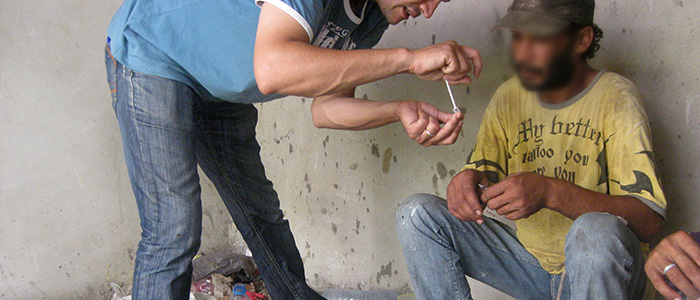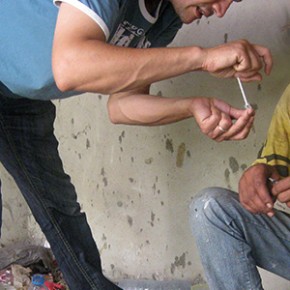* This article was published in the Global Fund Observer (English – French), Aidspan‘s newsletter.
 Just a glance at a map is enough to determine why Morocco is in the throes of an epidemic of injecting drug use. Sitting at the gates of Europe, its northern-most cities of Tangier, Tetouan and Nador are but a stone’s throw from the Spanish territories of Ceuta and Melilla: the crossroads of the African migration routes where all kinds of trafficking occur.
Just a glance at a map is enough to determine why Morocco is in the throes of an epidemic of injecting drug use. Sitting at the gates of Europe, its northern-most cities of Tangier, Tetouan and Nador are but a stone’s throw from the Spanish territories of Ceuta and Melilla: the crossroads of the African migration routes where all kinds of trafficking occur.
« There’s cannabis leaving Morocco and other drugs coming in from abroad, » explains Faoizia Bouzzitou, the educational coordinator for the Hasnouna Association to Support Drug Users (AHSUD in French).
In Tangier, AHSUD provides assistance to around 1,700 people who inject drugs, helping to dissuade them from sharing needles and engaging in other risky behaviors that put them at risk for HIV infection.
Such harm reduction programming is unique to Arab countries but has demonstrated results that show it can, and should, be replicated.  HIV prevalence among the drug users of Tangier is just 0.4% — in stark contrast to Nador, a city 400 km to the east that launched its harm reduction work a few years later, where HIV prevalence among drug users is above 20%. The divergent figures contribute to a national estimate of 10% sero-positivity among injecting drug users.
HIV prevalence among the drug users of Tangier is just 0.4% — in stark contrast to Nador, a city 400 km to the east that launched its harm reduction work a few years later, where HIV prevalence among drug users is above 20%. The divergent figures contribute to a national estimate of 10% sero-positivity among injecting drug users.
AHSUD began its work in 2007 with a bio-behavioral survey and a mapping of the injection sites in Tangier, says Bouzzitoun. « We needed to know who we were talking to, and the extent of the problem. You need an evidence base before you talk to decision-makers. »
These data were also the basis for AHSUD’s successful application for Global Fund support, to purchase injection kits to stock a mobile unit: a modest van into which four staffers would climb every day and prowl the squats and hidden spots where drug users would converge to get their fixes.
« We started downtown, in the M’sallah quarter, where most of the heroin users stay. They were shooting up in front of people’s houses, leaving their syringes where kids could play with them. Some young girls were even using the syringes to give henna tattoos, » recalls Bouzzitoun. « So part of the early effort was to work with drug users to change their behavior. We gave them single-use, sterile needles. We taught them about the risks of infection, and other risks like TB, or HIV or Hepatitis C. And we showed them how to shoot up in the least risky way, and avoid overdose and how to figure out an alternative when they don’t have works to fix. We are trying to point them towards health centers. »
It is there that the association finds some of its biggest challenges, confronting the stigmatization of injecting drug use. Be it by health professionals, including doctors and pharmacists, police, or the general public, they are finding it a painstaking and slow process to change people’s minds. With door-to-door campaigns, field teams gently demonstrate the importance of harm reduction to Tangier’s citizenry.
« It’s because drug users are someone’s sons, someone’s daughters, » says Bouzzitoun, that it boils down to a simple choice: « do you want them to be able to inject safely, with a chance to get off the drugs, or do we want them to be exposed to Hepatitis C, to HIV, and to risk spreading these illnesses to society? »
 AHSUD has also opened a field office in Hasnouna, providing a quiet and clean place for drug users to take a shower, wash their clothes, have a cup of coffee and, hopefully, participate in a support group session.
AHSUD has also opened a field office in Hasnouna, providing a quiet and clean place for drug users to take a shower, wash their clothes, have a cup of coffee and, hopefully, participate in a support group session.
Morocco’s journey to realizing the benefits of harm reduction programming has been a long and slow one. In 2010, opioid substitution therapy with methadone was launched in Tangier, Rabat and Casablanca: another program that received funding from the Global Fund as well as the Ministry of Health. And while methadone is no silver bullet, it helps reduce the risk of disease simply because it isn’t consumed intravenously. « So for 48 hours, a drug user can work, or shower, or eat — basically functioning like a regular person, » says Bouzzitoun.
The light at the end of heroin’s tunnel
Today, by broad consensus, AHSUD’s work is bearing fruit. « People we interviewed [for this documentary] say that it is not like it was before; there are fewer users, fewer drug injectors, less crime and less theft, » Bouzzitoun says proudly.
Also evolving is the mentality and attitudes of those who operate in the drug users’ orbit — specifically the police. « Now when a drug user is arrested, we get notified automatically by the police, who ask us to come and see if he needs treatment, » she says.
Risky behavior among drug users is also on the wane. Almost all of the injecting drug users supported by AHSUD use the kits of works they are given — syringe, spoon, filter, cotton and sterile water — and regularly participate in needle exchange. Among them are 400 people enrolled in a methadone program at the Medical Psychological Center next door.
These measures have really made the difference in helping bring down the HIV prevalence in Tangier’s drug-taking community. Also a contributing factor, said Bouzzitoun, is the HIV testing that around 80% of the people in the program have undergone. « We’ve done regular testing twice a week, every week, since 2008, » she says.
Now that the Tangier program has demonstrated such positive results, it was only natural that the program be extended to other major cities, beginning with Tetouan in 2009 and now Nador, Casablanca and Rabat.
 But that doesn’t mean that all of the problems associated with injecting drug use have been resolved. Hepatitis C, which afflicts more than half of the people who inject drugs, remains a threat. AHSUD has yet to be allowed into prisons and new drug users — kids aged 15 and 14 and, sometimes, even 13 — aren’t getting access to the group’s kits because they will require parental consent.
But that doesn’t mean that all of the problems associated with injecting drug use have been resolved. Hepatitis C, which afflicts more than half of the people who inject drugs, remains a threat. AHSUD has yet to be allowed into prisons and new drug users — kids aged 15 and 14 and, sometimes, even 13 — aren’t getting access to the group’s kits because they will require parental consent.
Even the methadone program, despite its excellent results that allow more than two-thirds of participants to return to a regular life once they’ve kicked their habits, is coming up short, not able to meet the needs. In Tangier alone the waiting list is more than 900-strong.
« Most users want to get off the drugs », AHSUD says, but there aren’t enough services available to them in the region: not enough treatment, not enough staff and not enough options within the health system to meet demand. The Medical Psychological Center, which works alongside AHSUD, must oversee the methadone treatment of 350 people and is not accepting new clients.
Tangier, MENA’s harm reduction laboratory
The first country in the Middle East and North Africa to introduce both harm reduction and methadone programs, Morocco is now sharing its experience through a training center also run by AHSUD in Tangier.
 In addition to providing technical support to their colleagues in Tetouan and Nador, AHSUD has brought in groups from Tanzania, Senegal, Tunisia, Algeria and Libya, sharing the experiences and lessons learned since 2007 with doctors, decision-makers and representatives from civil society.
In addition to providing technical support to their colleagues in Tetouan and Nador, AHSUD has brought in groups from Tanzania, Senegal, Tunisia, Algeria and Libya, sharing the experiences and lessons learned since 2007 with doctors, decision-makers and representatives from civil society.
They exhort the need for an evidence base, and provide guidance on how to forecast and plan to ensure that donors see the possibility for results. But mostly they plead for interlocutors to remember that people who inject drugs are just that: people. « We are trying to teach people how to approach users, how to talk to them and earn their trust, » says Bouzzitoun. « Because that is the only way you can reach them. »
Read this article in French. Lire l’article en français.





Laisser un commentaire
Rejoindre la discussion?N'hésitez pas à contribuer !